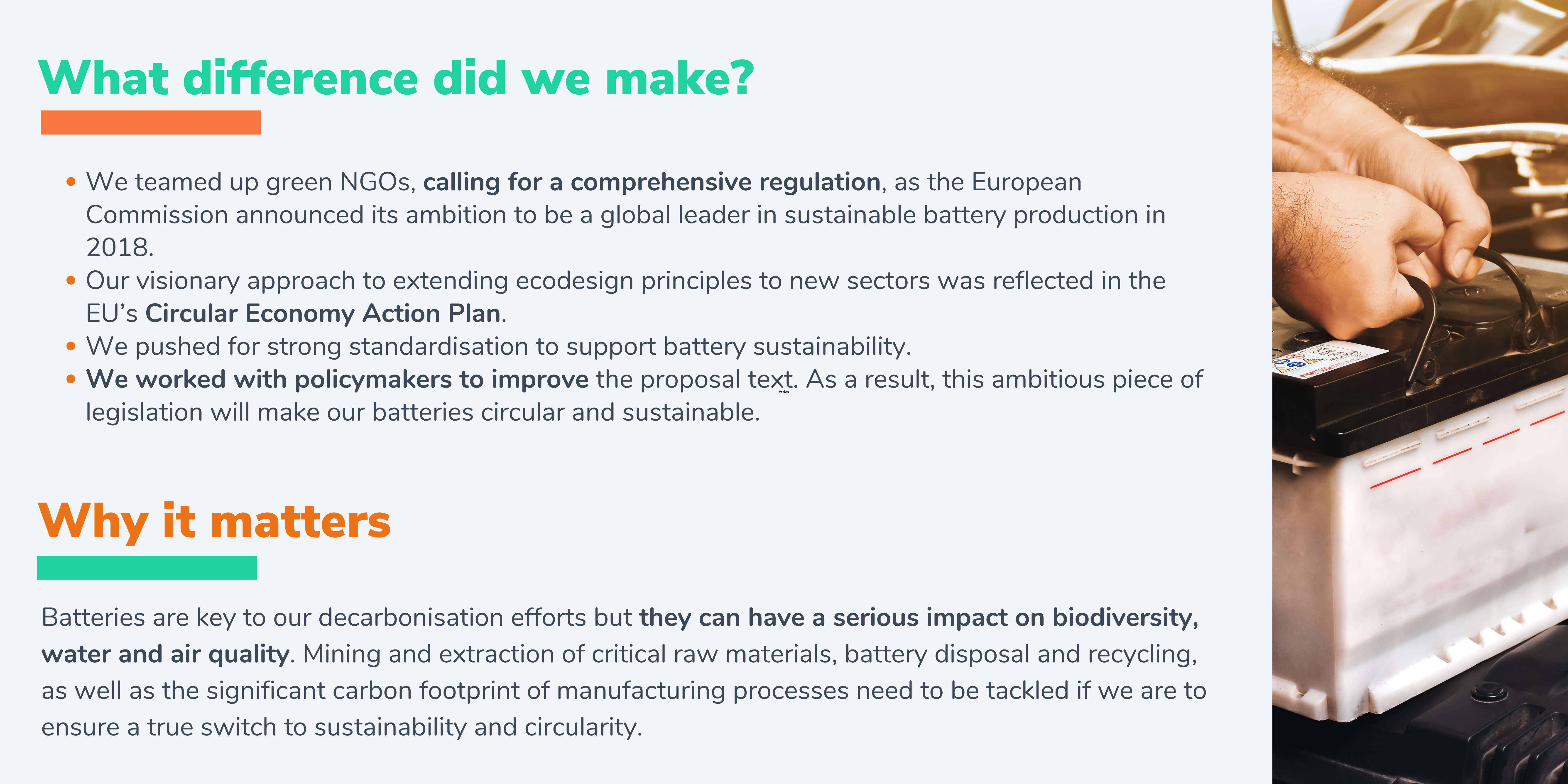The positive side of batteries
Batteries are the make-or-break of decarbonisation. But they also come at an environmental cost, which is why it is crucial to reduce their negative impacts. Luckily, one region of the world is taking the much-needed steps to ensure sustainability and circularity across the board: the EU Battery Regulation is the first-ever product policy that covers the entire product value chain. In 2023, ECOS saw this work through – and celebrated the outcomes.
We need them to operate our electric vehicles (and so many other appliances!), or to store our energy. The positive side of batteries needs no explaining, and their role in our decarbonisation efforts is equally clear. But the dark side of batteries should not be overlooked: they can have a serious negative impact on biodiversity, water and air quality, resulting from the mining and extraction of critical raw materials, as well as battery disposal and recycling. These harmful side-effects grow even more if battery manufacturing processes are inefficient and use carbon-intensive, non-renewable sources.

The full picture
It is not enough to electrify – we need to make sure we dot all the I’s and cross all the T’s. In other words, we need batteries which are sustainable throughout their entire life cycle – from the sourcing of materials to their collection, recycling and repurposing. Only this way can we ensure a clean energy transition that is also circular and toxic-free.
ECOS pointed to such a “full picture” approach early on. About the time as the European Commission announced its ambition to be a global leader in sustainable battery production in 2018, we joined forces with other green NGOs, calling for a comprehensive regulation, which would cover all kinds of batteries along the entire value chain. Our visionary approach to extending ecodesign principles to new sectors paid off: two years later, the flagship Circular Economy Action Plan committed the EU to developing a framework for batteries. Better still, it also pledged to solve existing standardisation obstacles, which, not surprisingly, was music to our ears.
And we were there every step of the way, working closely with policymakers and standardisers alike: from impact assessment to proposal text to environmentally ambitious standards that would eventually support it.
From good to better
While the first (2020) proposal for the Battery Regulation was good, we successfully worked with our network to make it even better. Our recommendations pushed policymakers to improve a number of provisions, in particular with regard to such crucial aspects as carbon footprint, circularity, collection, reuse potential, recovery of critical materials, their ethical sourcing, or recycled content in new batteries.
We were extremely active in the co-decision process, capitalising on every opportunity to push for environmentally ambitious solutions: from technical papers to podcasts to press work, we left no stone unturned. We set the civil society narrative on this topic, recognising the key role of batteries in electrification but also their potential negative impacts. Eventually, this led to an ambitious proposal text – something we are particularly proud of.
Our standard asks
We would not be Environmental Coalition on Standards if we didn’t cover this important aspect of the work too. Even the most visionary legislation will not realise its full potential without the support of ambitious standards. This is why we pushed for strong standardisation developments along the way, which would support the sustainability of batteries and cover many existing standardisation gaps, such as lack of methodologies to assess battery age and its reuse potential, or to define the necessary conditions for safe repairability. We wrote reports, organised events, and made clear links between the standardisation world and EU policymaking: something we are particularly comfortable with, and uniquely placed to do. These efforts did not go unnoticed by the press, which once again echoed our narrative, and helped mainstream the understanding of the battery big picture.
A one-of-a-kind outcome
Seeing the final text was satisfying. Most of our asks made the cut, with the Battery Regulation proposal putting forward strong provisions on better performance, repairability, reuse, carbon footprint, as well as targets for recycled content or material recovery for critical substances such as lithium.
Importantly, the Regulation also empowered the European Commission to develop common specifications if European standards are lacking, late or not fit for purpose – a point for which we advocated strongly, and untill the very end.
This Regulation is truly one of a kind, and served as a blueprint for the flagship Ecodesign for Sustainable Products Regulation, which will introduce ecodesign principles to a great many sectors and products.
The equally important next steps
The work is of course not done – the next crucial step is implementation. The Regulation sets the tone and the ambition is commendable, but, even as you read this, many important details are being developed in secondary legislation and standards. But ECOS will be there to be the voice of the positive side of batteries – and ensure environmental ambition every step of the way.


